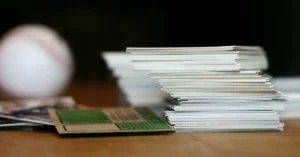Avoid turnovers with my expert advice: what is a turnover in basketball? Learn about the costly mistake and strategies for minimizing turnovers.
What is a Turnover in Basketball?
Defining a Turnover
A turnover occurs when you, as a player, lose possession of the ball to the opposing team before a shot is attempted. This can be due to various violations or errors, resulting in an immediate shift of control, giving the other team a chance to score. Some turnovers happen because of an offensive foul or a shot clock violation.
Common Types of Turnovers
When discussing turnovers, there are specific types you should be aware of:
- Traveling: Taking too many steps without dribbling.
- Double Dribble: Dribbling with both hands or stopping and restarting your dribble.
- Three-Second Violation: Staying in the key for more than three seconds while your team is on offense.
- Five-Second Violation: Failing to inbound the ball within five seconds.
- Offensive Fouls: Illegal contact committed by an offensive player.
These actions violate the rules and result in the ball being handed over to the opposing team.
Turnover in Basketball Context
In the context of basketball, turnovers can significantly impact the game’s outcome as they provide the opposing team with extra opportunities to score. For example, a forced turnover might occur when a defender steals the ball or intercepts a pass. In contrast, an unforced turnover could result from a player’s mistake like a bad pass.
Rules and Violations Leading to Turnovers

What is the Shot Clock?
In basketball, the shot clock is a timer designed to increase the game’s pace and scoring. Once your team has possession, you only have a – typically 24 seconds – to attempt a shot that hits the rim. If your team fails to do so, it’s a violation that results in a turnover, and the ball is awarded to the other team.
Boundary Violations
You must be mindful of the court’s boundaries during play. If you or the ball you’re holding or dribbling goes out of bounds, that’s a turnover. The same goes for a bad pass that lands outside the playing area. Opponents gain possession from the spot nearest to where the violation occurred.
Personal and Technical Fouls
Now let’s talk about offensive fouls. An offensive foul occurs when you, as an offensive player, illegally contact a defender set in position. This type of personal foul can cause your team to forfeit possession to the other team.
Technical fouls also cause turnovers, but these are a bit different—they violate basketball’s code of conduct rather than gameplay. This includes inappropriate behavior by players or coaches, like arguing with referees or not following the game’s procedural rules.
Remember, several actions can lead to turnover through violations. Understanding them helps you appreciate the strategy and skill that goes into every possession in basketball. Play smart and watch the game unfold!
Player Actions Resulting in Turnovers

When playing basketball, it’s crucial for you to maintain possession of the ball. However, various mistakes by an offensive player can lead to turnovers, which are events where your team loses the ball to the opponent.
A turnover can be either forced by the opposing team’s good defense or an unforced error that’s a result of your team’s mistake.
Offensive Player Mistakes
Mistakes made by you or another offensive player can directly lead to turnovers. This includes traveling when you move illegally with the ball without dribbling or when you commit a double dribble. Other errors include offensive fouls like charging, where you collide with a set defender, or when you step out of bounds with the ball.
- Stepping out of bounds
- Traveling
- Double dribble
- Offensive fouls (e.g., charging)
Dribbling Errors
Your dribbling must be controlled and vigilant to avoid turnovers. Common dribbling errors that result in a turnover include having the ball stolen while dribbling or losing control of the ball out of bounds. Over-dribbling in the face of a tight defense can also lead to turnovers, as can dribbling into a trap set by the opposing team.
- Ball stolen while dribbling
- Losing control and ball out of bounds
- Dribbling into opponent’s defense trap
Passing Missteps
Passing requires precision. Bad passes can easily lead to turnovers, like throwing the ball where it’s easily intercepted by the defense or making a pass that’s too difficult for your teammate to catch. Poor decision-making, such as passing into a crowded area or misjudging a teammate’s location, can also contribute to turnovers.
- Pass intercepted
- Throwing to an area easy for defense to steal
- Passing into a crowded space
- Misjudgment of a teammate’s position
Statistics and Record-Holding Players

NBA Turnover Records
Turnover Rate is a valuable statistic that measures turnovers per 100 plays. Understanding this helps you appreciate the efficiency of playmakers under pressure.
- NBA Record for lowest team turnover rate in a season goes to the 2018-19 Milwaukee Bucks. (Basketball Universe)
Notable Players and Teams
Several players stand out when it comes to turnovers, not just for their slip-ups, but for their legendary status and playmaking abilities:
- John Stockton and Karl Malone are known for their incredible partnership on the court, though Malone also accrued a significant number of turnovers.
- Jason Kidd, known for his on-court vision and assists, is among the NBA players with the most turnovers in history due to his high usage and playmaking role.
- LeBron James, James Harden, and Russell Westbrook are modern-day players who, while they rack up impressive stats across the board, have also had high turnover numbers. It’s often a side effect of high ball possession and aggressive playmaking. Player Turnovers LeBron James High James Harden High Russell Westbrook High Moses Malone Noteworthy
Moses Malone is another notable player who, despite being a phenomenal rebounder and scorer, also had a notable number of turnovers in his career. Remember, turnovers can be as much a reflection of player usage as they are of mistakes on the court.
Preventing and Forcing Turnovers

Defensive Strategies
To effectively prevent turnovers, you need to focus on strong defensive play. Always be aware of the opposing team’s screens and movements. By anticipating their actions, you can position yourself to disrupt passing lanes and increase the chances of a steal. Applying consistent defensive pressure without fouling is key. This pressure can lead to forced turnovers, such as when your opponent makes a hurried pass or mishandles the ball.
- Tips for individual defense:
- Stay on the balls of your feet.
- Keep your eyes on your opponent’s waist or chest to anticipate their movement.
- Use quick hand movements to disrupt passing and dribbling.
Coaching Tactics
As a coach, incorporating drills that emphasize turnover prevention is important. Encourage your players to communicate on the court; a simple call out can alert a teammate to a looming defensive trap. Your game plan can also include specific defensive pressure tactics, such as a full-court press, to force the opposing team into uncomfortable situations, increasing the likelihood of a forced turnover.
- Coaching tips to reduce turnovers:
- Practice “pass fakes” to throw off defenders.
- Reinforce the importance of good decision-making with the ball.
- Incorporate conditioning drills that improve ball-handling under fatigue.
The Impact of Turnovers on Game Outcomes
A turnover in basketball occurs when the team on offense loses possession of the ball to the defense, which can drastically influence the score and momentum of the game. Teams work diligently to reduce turnovers as they can be the differentiator between a win and a loss.

Momentum Shifts and Scoring Opportunities
When your team commits a turnover, it’s more than just a lost scoring chance; it’s a potential catalyst for the opposing team to capitalize on your mistake. A swift change in momentum due to a turnover can lead to a scoring run, altering the pace and energy of the game. Particularly harmful are live-ball turnovers where the defense can quickly transition into offense, providing them with easy scoring opportunities.
Turnovers in Critical Game Moments
During tight games, each possession gains heightened significance. A turnover can be incredibly costly if it occurs in these critical moments, like during the playoffs or the final minutes of a game. It’s a fine balance to tread; taking risks to score while safeguarding against the turnover that could give the other team an edge. Whether it’s a lost dribble, a bad pass, or a traveling violation, turnovers at crucial times can be a team’s undoing, especially when team turnover rates are high.
FAQ
What is the difference between a steal and a turnover in basketball?
A steal occurs when a defensive player legally takes possession of the ball from an offensive player without committing a foul. On the other hand, a turnover refers to any loss of possession by the offense, including errors such as bad passes, traveling violations, or offensive fouls.
Who has the most turnovers in NBA history?
As of my last update, John Stockton holds the NBA record for the most turnovers in his career, with a total of 4,244 turnovers over his illustrious career.
How is turnover calculated in the NBA?
In the NBA, turnovers are tracked as a statistic for both individual players and teams. A turnover occurs when a player loses possession of the ball to the opposing team, either through a steal by the defense, an errant pass, a traveling violation, or another infraction. Turnovers are counted and recorded in the game’s official statistics and are often used to evaluate player and team performance.
If you enjoyed reading about the topic: What is a Turnover in Basketball, leave a comment and stay updated on Pinterest for more exciting basketball news.
Leave me a comment and make sure to also check out What is Basketball Bonus.





